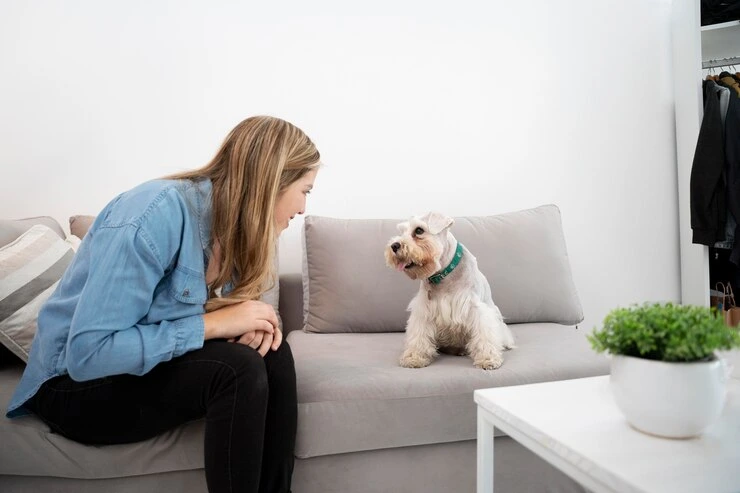-
P, 193, A, Ramakrishna Samadhi Rd,Kolkata- 700054
P, 193, A, Ramakrishna Samadhi Rd,Kolkata- 700054

Hello Reader!
Welcome to the blog page of APC Pet Clinic, one of the best pet clinic in Kolkata.
As pet owners, we always want our furry companions to be happy and stress-free. However, just like humans, animals can also suffer from anxiety. Dealing with Anxiety in Pets requires understanding the causes, symptoms, and effective ways to manage and treat their distress. If your beloved pet is showing signs of stress, consulting the best pet clinic in Kolkata can help you find the right solutions.

Pets experience anxiety for a variety of reasons. Understanding the underlying cause is the first step toward effectively dealing with anxiety in pets. Here are some common triggers:
Recognizing the symptoms of anxiety in pets can help in early intervention. Common signs include:

To determine if your pet is experiencing anxiety, observe for several key signs and behavioral changes. Here are the main indicators to look for:
If you observe any combination of these signs consistently, it is advisable to consult with a veterinarian for further evaluation and potential treatment options.
Also Read: Kidney Diseases in Dogs: A Guide to Dog Kidney Problems

While dealing with anxiety in pets, pet owners must adopt a combination of training, environmental modifications, and medical support. Here are effective strategies:
Providing a quiet, cozy area where your pet feels safe can significantly reduce anxiety. A crate, bed, or designated room with their favorite toys can help them feel secure.
Pets thrive on consistency. Feeding, walking, and playtime should occur at the same time daily to create stability and reduce stress.
Gradual exposure to new people, environments, and experiences can help pets overcome their fears. Positive reinforcement techniques, such as rewarding calm behavior with treats, are effective.
Regular physical activity like walks, interactive games, and puzzle toys help release pent-up energy and anxiety.
If your pet’s anxiety is severe, seeking professional help from the best pet clinic in Kolkata is essential. A vet may recommend behavioral therapy, supplements, or in extreme cases, medication to manage anxiety.

To help relieve anxiety in pets through car rides, it’s essential to approach the process gradually and consistently. Here are some guidelines on how often and how to incorporate car rides into your pet’s routine:

To effectively treat anxiety in pets, particularly dogs, positive reinforcement techniques can be incredibly beneficial. These methods focus on rewarding desired behaviors rather than punishing unwanted ones, fostering a trusting and supportive relationship between you and your furry friend. Here are some of the best positive reinforcement techniques for managing anxiety in pets:
Treats are one of the most effective forms of positive reinforcement. When your pet exhibits calm behavior or responds positively to a command, reward them immediately with a small, tasty treat. This immediate reward helps your pet associate the calm behavior with something pleasurable, encouraging them to repeat it in the future.
Clicker training is a precise method of positive reinforcement that uses a clicker to mark desired behaviors. When your pet performs the desired action, you click the device and then give a treat. This technique provides clear feedback and helps your pet understand exactly what behavior is being rewarded.
In addition to treats, verbal praise such as “good boy” or “well done” can reinforce desired behaviors. Dogs thrive on attention and approval from their owners, so combining verbal praise with physical affection—like petting or belly rubs—can enhance the effectiveness of your training.
For pets with specific fears (like loud noises), gradual desensitization can be an effective technique. Start by exposing your pet to the anxiety-inducing stimulus at a low intensity while rewarding them for remaining calm. As they become more comfortable, gradually increase the exposure level while continuing to reward calm behavior.
Counterconditioning involves changing your pet’s emotional response to a trigger by associating it with something positive. For instance, if your dog is anxious about strangers, have them perform a command like “sit” when someone approaches and reward them for doing so. This shifts their focus from anxiety to obedience and rewards.
Establishing a consistent routine helps reduce anxiety as pets feel more secure in predictable environments. Use positive reinforcement consistently across all training sessions to help your pet understand what is expected of them. Consistency in rewards and commands is crucial for effective training.
Incorporating play into training sessions can also serve as positive reinforcement. Use their favorite toys or games as rewards for good behavior, making training fun and engaging while also providing mental stimulation.
Lastly, it’s essential to approach training with patience and empathy. Anxiety in pets can take time to overcome, and each pet will progress at their own pace. Celebrate small victories and remain supportive throughout the process.

To help your pet overcome separation anxiety, it’s important to implement a combination of behavior modification techniques, environmental adjustments, and consistent routines. Here are several effective strategies:
Designate a comfortable area where your pet feels secure. This could include a cozy bed, favorite toys, and items that carry your scent, such as worn clothing. This space should be associated with positive experiences to help them feel safe when alone.
Utilize positive reinforcement techniques to encourage calm behavior. Reward your pet with treats and praise when they remain calm during short separations or when they exhibit relaxed behavior in their safe space.
This involves changing your pet’s emotional response to being alone by associating it with something positive. For example, give them a special treat or toy only when you leave, helping them associate your departure with a pleasant experience.
Establishing a consistent daily routine can provide stability for your pet. Regular feeding times, exercise schedules, and playtime help create predictability, which can reduce anxiety levels.
If your pet’s separation anxiety is severe and leads to destructive behaviors or self-harm, consult a veterinarian or a certified animal behaviorist. They may recommend anti-anxiety medications as part of a comprehensive treatment plan alongside behavioral training.
Never punish your pet for anxious behaviors; this can worsen their anxiety and damage the trust between you and your furry friend. Instead, focus on understanding their needs and providing support.
If your pet’s anxiety is interfering with their daily life and home environment, it’s time to consult a veterinarian. At APC Pet Clinic, the best pet clinic in Kolkata, our team specializes in diagnosing and treating anxiety in pets with expert guidance and care. We offer:

Excessive barking, pacing, destructive behavior, hiding, trembling, and loss of appetite are common signs of anxiety in pets.
Create a safe space, use calming music, provide a comforting toy, and stay close to reassure them.
Yes, regular exercise and mental stimulation help release excess energy and reduce stress in pets.
If anxiety symptoms persist, worsen, or interfere with daily life, consult a vet for professional guidance and possible treatments.
Yes, pheromone diffusers, calming supplements, aromatherapy, and gentle pet massages can help soothe anxious pets.
Understanding and dealing with anxiety in pets is crucial for their overall well-being. Identifying triggers, offering comfort, training, and consulting professionals when needed can significantly improve your pet’s quality of life. If you suspect your pet is suffering from anxiety in pets, don’t hesitate to visit APC Pet Clinic, the best pet clinic in Kolkata, for compassionate and expert care. A stress-free pet means a happy and healthy companion for years to come!